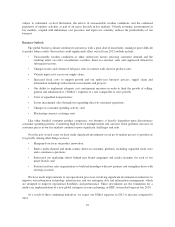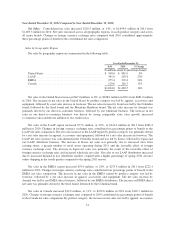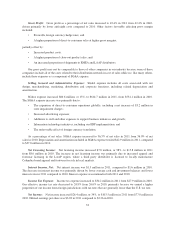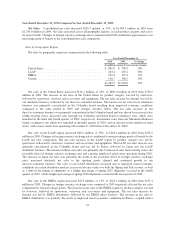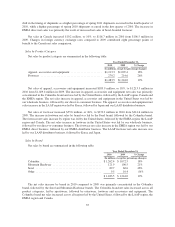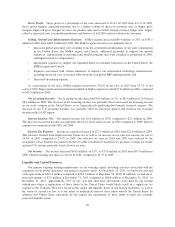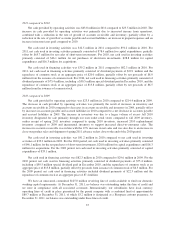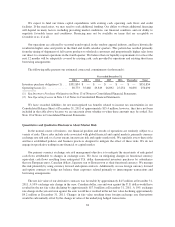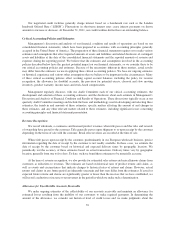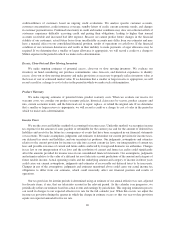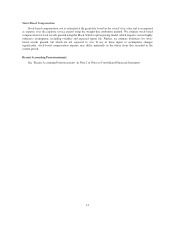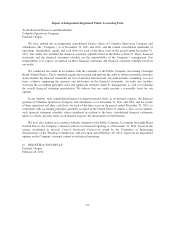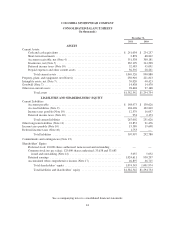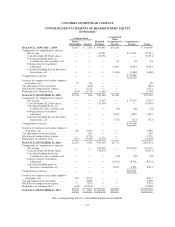Columbia Sportswear 2011 Annual Report Download - page 44
Download and view the complete annual report
Please find page 44 of the 2011 Columbia Sportswear annual report below. You can navigate through the pages in the report by either clicking on the pages listed below, or by using the keyword search tool below to find specific information within the annual report.Our negotiated credit facilities generally charge interest based on a benchmark rate such as the London
Interbank Offered Rate (“LIBOR”). Fluctuations in short-term interest rates cause interest payments on drawn
amounts to increase or decrease. At December 31, 2011, our credit facilities did not have an outstanding balance.
Critical Accounting Policies and Estimates
Management’s discussion and analysis of our financial condition and results of operations are based on our
consolidated financial statements, which have been prepared in accordance with accounting principles generally
accepted in the United States of America. The preparation of these financial statements requires us to make various
estimates and assumptions that affect reported amounts of assets and liabilities and related disclosure of contingent
assets and liabilities at the date of the consolidated financial statements and the reported amounts of revenue and
expenses during the reporting period. We believe that the estimates and assumptions involved in the accounting
policies described below have the greatest potential impact on our financial statements, so we consider these to be
our critical accounting policies and estimates. Because of the uncertainty inherent in these matters, actual results
may differ from the estimates we use in applying these critical accounting policies. We base our ongoing estimates
on historical experience and various other assumptions that we believe to be important in the circumstances. Many
of these critical accounting policies affect working capital account balances, including the policy for revenue
recognition, the allowance for doubtful accounts, the provision for potential excess, closeout and slow moving
inventory, product warranty, income taxes and stock-based compensation.
Management regularly discusses with our Audit Committee each of our critical accounting estimates, the
development and selection of these accounting estimates, and the disclosure about each estimate in Management’s
Discussion and Analysis of Financial Condition and Results of Operations. These discussions typically occur at our
quarterly Audit Committee meetings and include the basis and methodology used in developing and selecting these
estimates, the trends in and amounts of these estimates, specific matters affecting the amount of and changes in
these estimates, and any other relevant matters related to these estimates, including significant issues concerning
accounting principles and financial statement presentation.
Revenue Recognition
We record wholesale, e-commerce and licensed product revenues when title passes and the risks and rewards
of ownership have passed to the customer. Title generally passes upon shipment to or upon receipt by the customer
depending on the terms of sale with the customer. Retail store revenues are recorded at the time of sale.
Where title passes upon receipt by the customer, predominantly in our European wholesale business, precise
information regarding the date of receipt by the customer is not readily available. In these cases, we estimate the
date of receipt by the customer based on historical and expected delivery times by geographic location. We
periodically test the accuracy of these estimates based on actual transactions. Delivery times vary by geographic
location, generally from one to five days. To date, we have found these estimates to be materially accurate.
At the time of revenue recognition, we also provide for estimated sales returns and miscellaneous claims from
customers as reductions to revenues. The estimates are based on historical rates of product returns and claims, as
well as events and circumstances that indicate changes to historical rates of returns and claims. However, actual
returns and claims in any future period are inherently uncertain and thus may differ from the estimates. If actual or
expected future returns and claims are significantly greater or lower than the reserves that we have established, we
will record a reduction or increase to net revenues in the period in which we make such a determination.
Allowance for Uncollectible Accounts Receivable
We make ongoing estimates of the collectability of our accounts receivable and maintain an allowance for
estimated losses resulting from the inability of our customers to make required payments. In determining the
amount of the allowance, we consider our historical level of credit losses and we make judgments about the
39


